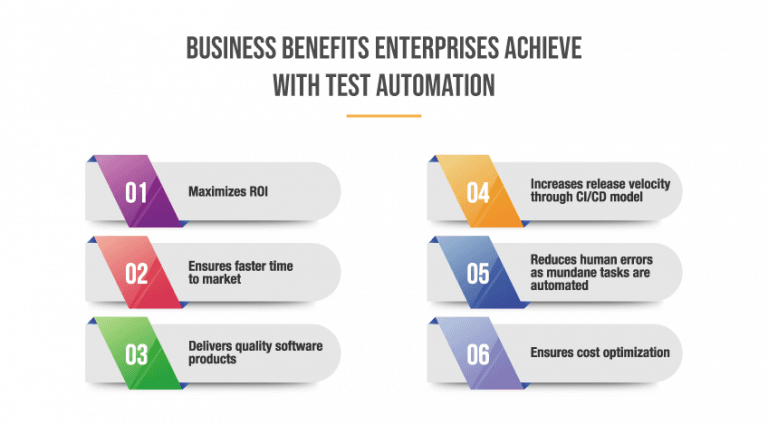Recommended Blogs
Role of Test Automation in Agile and DevOps

Content
1. Agile and DevOps Methodologies
2. Role of Test Automation in Agile and DevOps
4. What are 5 Ways to Make Test Automation Successful in Agile?
6. What are the Best DevOps Practices to Follow?
7. Major Benefits of Test Automation
Agile and DevOps Methodologies
During the Waterfall Model of software development, software testing was taken up at the end of the software development life cycle (SDLC) and it resulted in many bugs, thus delaying the release time. Such method of software testing at the end of the SDLC does not hold good anymore and with Agile and DevOps methodologies on the go. When the testing process actually starts at the beginning of the code development stage, it is specifically referred to as Shift-left approach wherein testing goes hand in hand with development, in an order of Continuous Integration (CI) /Continuous Delivery (CD) method. Evidently, with testing taking place in parallel to code development under DevOps methodology, it suffices the CI, CD and Continuous Testing (CT) process. But, still organizations today face a lot of Quality Assurance (QA) challenges such as time constraints in development and test cycles while manually testing diverse applications. Hence, the most efficient way to deal with testing applications is to adopt a well-integrated and robust test automation solution that can predict and simulate business scenarios. It should be coupled with an appropriate test automation strategy in agile, approach and a well-defined test automation framework to deliver quality software at speed under agile and DevOps environments.
Role of Test Automation in Agile and DevOps
Agile Environment
Under an agile environment with iterative & an incremental model in place, Test automation delivers quality at speed within sprints, as functionality can be developed and tested rapidly. It is common that agile teams are spread across geographies and setting of infrastructure across, becomes a costly deal. But, cloud-based test automation tools allow the teams to access the tool from any device and collaborate towards achieving the end goal for delivering a quality product. It has also been observed that under agile scenarios, the number of tests continues to increase exponentially across each iteration and an automation tool would efficiently handle it and ensures early to the market. Moreover, under Agile, you can automate your functional and regression tests to ensure the product performs quickly and exactly as per the requirements.
What are 5 Ways to Make Test Automation Successful in Agile?
Implement Parallel Testing:
In agile methodology, continuous releases in multiple iterations could cause the test automation teams to miss the quality standards. By following parallel testing with the development cycles, it helps to identify the bugs, fix the issues and test them effectively. This will be an efficient way to increase productivity and avoid last-minute surprises.
Adopt the Right Automation Tool:
It is essential to select and invest in the right automation tool by validating the tool capabilities. It is necessary to ensure whether the selected automation tool meets the expected features or criteria for successful test automation under an agile environment.
Maintain smaller test cases:
It is important to run test cases that are small. This will eliminate the unnecessary data which might not add any difference with or without the addition of the data to the test case. In addition to this, smaller test cases help to make changes easily according to the regression testing requirements.
Monitor the Development Environments:
It is crucial to continuously monitor the developers and development environment to understand the functionality. There are a number of phases in a software development process – it comprises of a network, back-end to front-end system architecture, etc. Hence, it is important to understand the functionality and their association with product development. This will help to focus on the product quality rather than finding the bugs through different data.
Implement Quality Tests:
Developing robust tests is an important factor to make test automation successful in agile. This will help the developers to create quality scripts that can easily integrate with the regression testing. The test scripts should be flexible to fulfil the regression testing requirements by meeting the criterion of accuracy, portability, integrity, portability, performance, etc.
DevOps Environment
To achieve speed and agility in DevOps, it is important to automate all the testing processes and configure them to run automatically when the deployment is completed in the QA Environment. Specialized automation testing tools and continuous integration tools should be used to achieve this integration to deliver quality. As DevOps embraces a culture shift, it breaks silos to build, test and deploy applications, in order to achieve quality with reduced deployment times. Automation tools play an important role to achieve the implementation of CI/CD/CT. Thus, Test automation is undoubtedly the secret to the success of DevOps.
What are the Best DevOps Practices to Follow?
Consider Infrastructure as Code (IaC):
This practice is used in various phases of DevOps. It is used for automating the infrastructure that is required for releasing software. Usually, the infrastructure code is added by the developers from their existing development tools.
Practice Continuous Integration (CI):
Within this practice, tools related to configuration management (CM) are brought together with the development tools to trace out whether the code which is being developed is ready for production or not. This practice involves continuous feedback from the testing and development teams, and thus it becomes easier to solve the issues related to code.
Implement Test Automation:
To achieve quality code, it is essential to implement the practice of regular testing. In DevOps test automation, developers can fix the errors in the code in the development phase itself. Hence, implementing test automation in the DevOps framework will speed up the SDLC. Also, there will not be any need to perform repetitive test cases to prevent the bugs. 
Major Benefits of Test Automation
– Delivers accurate test results and ensures quality deliverables – Facilitates automating maximum steps that can be possibly automated – Increases the speed of test execution – Provides rapid feedback to reduce the cost of fixing defects quickly and efficiently – Saves time enormously due to shorter test cycle times – Removes tedious tasks with the automation of such tasks – Frees up manual testers (team members) who can be utilized for other tasks – Ensures all measures to maximize benefits, while minimizing costs – Parallel execution of tests helps in reducing time-to-live, which in turn is the crux of a successful DevOps implementation – Test automation also plays an important role in Shift-Left approach, as it unlocks continuous testing throughout the SDLC reducing the feedback loop and costs associated with testing

Conclusion:
The software testing process has been taking a shift-left approach for a while now, wherein testing is executed in parallel with the development leveraging the CI/CD approach. With the agile and DevOps on the go, test automation needs to be adopted by every enterprise to achieve quality at speed. TestingXperts has profound knowledge and ability to perform test automation and devops has delivered significant cost savings to the clients. TestingXperts’ Test Automation Framework (Tx-Automate) helps in drastically reducing the effort to kick-start automation and offers a fully operational test automation solution. Tx-Automate further helps in enhancing the quality and consistency of testing by removing all possible manual errors and increases the test coverage by creating the testing process more efficient to ensure quality at speed. Connect with our Test Automation Experts to leverage our next-gen QA services.
Discover more
Stay Updated
Subscribe for more info
